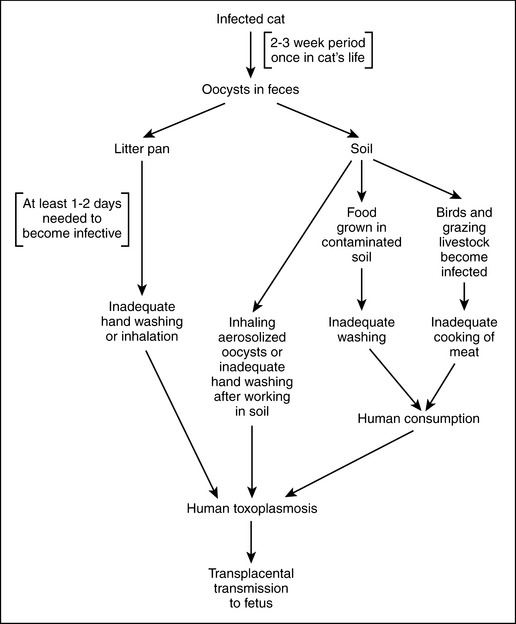TOXOPLASMOSIS
Cats have gotten a bad rap about how they transmit toxoplasmosis to humans and how they cause spontaneous abortion in women and blindness and mental retardation in newborns and older children. While it is true that cats are the only definitive host for the infective stage of the Toxoplasma organism, they are not the most common source of human infection. The most efficient way to get toxoplasmosis from a cat is to eat the cat undercooked!
ETIOLOGY: PARASITIC
The asexual phase occurs when the oocysts become infective, or sporulate, 1 to 5 days after they are passed in the feces. These oocysts are resistant to environmental conditions and can remain infective for over a year. When the sporulated oocysts are ingested by an animal, they go to the animal’s small intestine, enter the tachyzoite stage, penetrate the intestinal wall, and travel to other parts of the body in lymph and blood. During this stage, tachyzoites rapidly multiply in the cytoplasms of monocytes and macrophages. The tachyzoite (asexual) stage, which is called the active or acute phase, lasts until the host’s immune system produces some immunity—about 2 weeks. Once the immunity develops, the tachyzoites slow their multiplication rate and become bradyzoites, which accumulate in the cytoplasm of tissue cells and form cysts. The cysts can be found anywhere in the body, but are most commonly seen in skeletal muscle, myocardium, and brain tissue. The bradyzoite (asexual) stage is the inactive phase. Cysts can remain in the host for the rest of its life. If the host’s immunity is somehow suppressed, the bradyzoites can become rapidly multiplying tachyzoites again, resulting in a latent or chronic infection (Figure 46).
Stay updated, free articles. Join our Telegram channel

Full access? Get Clinical Tree



